1. 서 론
2. 방수공법 및 특징
3. 에폭시 방수공법
4. 고속도로 교면포장 시공사례
5. 시공결과 및 요약
1. 서 론
교면포장은 교량슬래브 상부에 시공되어 다양한 기상환경 및 교통환경에 노출된다. 온도변화에 따른 콘크리트 슬래브 수축팽창, 차량 통행 시 충격하중과 진동에 의한 슬래브의 휨거동은 교면포장에 적용되는 포장재료에 우수한 균열 저항성(crack resistance)과 변형 저항성(rutting resistance)을 요구한다.
한편, 교면포장 파손은 소성변형, 균열, 포트홀, 밀림 등 다양한 형태로 나타나고 있으며, 파손 부위로 강수가 침투하고 반복되는 동결융해 작용은 포장체 내구성을 약화시켜 포장 파손을 가속시킨다. 더불어 동절기 도로 결빙방지를 목적으로 제설제 사용과 이로 인한 제설제의 포장체 내부 침투는 콘크리트 슬래브의 내구성을 감소시키는 열화현상의 원인이다.
따라서 국내 고속도로 교면포장 유지보수 시 다양한 교면방수공법을 적용하고 있다(Korea expressway corporation, 2021). 이는 포장 하부로 침투한 우수의 콘크리트 슬래브 침투를 억제하여 슬래브 열화 방지를 목적으로 하며, 나아가 상부 교면포장의 내구성 및 수명을 증대시키고자 하는 것이다. 하지만 교면 상부포장 파손시 하부 방수층의 파손과 부착력 저하로 인한 밀림 및 들뜸 현상 등의 문제가 여전하며, 이를 해결하고자 다양한 공법이 개발되어 적용중에 있다.
본 기사에서는 교면포장 유지보수에 적용되는 다양한 방수공법 중 에폭시 역청계 도막방수 공법에 관한 현장적용 사례를 소개하였다. 국내에 적용되는 다양한 교면방수 재료 중 에폭시 수지를 사용한 2액형 방수공법은 시공이 간단하고 방수성능과 내구성이 우수한 공법으로 향후 확대 적용이 기대된다.
2. 방수공법 및 특징
교면포장에 있어 콘크리트 슬래브와 방수층, 방수층과 포장의 일체 거동에 요구되는 인장 및 부착성능과 방수성능은 교면포장의 내구성과 공용수명에 영향을 미치는 중요한 요인이다. 국내에서 대표적인 교면방수 공법은 아스팔트 방수, 포장식 방수, 부착시트식 방수, 도막식 방수, 복합식 방수공법 등이 있다. 각 방수공법의 특징과 고속도로 교면방수에 적용되는 방수재 품질기준은 Table 1 및 Table 2와 같다.
Table 1.
Type and characteristics of waterproofing methods
|
Method
|
Advantage
|
Weakness
|
Attached Sheet
부착시트식 방수
|
∙Securing material quality (factory production)
∙Easy construction
∙재료품질 확보 용이
∙시공용이 및 연속 시공 가능
|
∙Concerns about sheet joint defects
∙Cracking and shoving may occur if there is
insufficient adhesion with pavement layer
∙시트 결합부 불량 우려
∙포장층 부착력 부족 시 균열 및 밀림 발생 우려
|
Membrane
Waterproofing
도막식 방수
|
∙Easy to secure material qulity
∙Construction is simple and continuous construction is
possible
∙Complex cross-section construction is possible
∙재료품질 확보 용이
∙시공용이 및 연속 시공 가능
∙복합단면 시공 가능
|
∙Difficult to secure a certain coating thickness by
difference in uneven depth depending on the shape
of removed concrete slab surface
∙Difficult to secure waterproof performance due to
punching caused by subsequent processes
(aggregates etc.)
∙콘크리트 슬래브 바닥면 성상(요철)에 따른
전단면 적정(규정) 도막두께 확보 어려움
∙방수 후 공정에서 발생하는 펀칭 등의 이유로
방수성능 확보 어려움
|
Combined
Waterproofing
복합식 방수
|
∙A method that combines the membrane type
and attached sheet type
∙Complete the shortcomings of membrane and
sheet type
∙시트식 및 도막식 공법의 조합
∙시트식 및 도막식 공법의 단점 보완
∙방수성능 개선
|
∙Increased construction time
∙Increased waterproofing costs, including materials
costs
∙시공시간 증가
∙방수 비용증가 및 재료 소모량 증가
|
Pavement
Waterproofing
포장식 방수
|
∙Guss or Mastic asphalt mix.
∙Self-leveling effects
∙Excellent adhesion to concrete slab
∙Excellent waterproofing performance and
continuous construction possible
∙구스 또는 매스틱 아스팔트 혼합물
∙셀프 레벨링 효과
∙콘크리트 슬래브와 우수한 부착력
∙우수한 방수성능과 연속시공 가능
|
∙Increased fuel consumption, oil vapor generation,
and increased costs due to mixture production at
high temperature
∙Dedicated transport truck (cooker) required
∙Concerns of low-temperature cracks occurring
∙연료 소모 증가 및 유증기 발생, 고온에서 방수재
생산에 따른 비용 증가
∙전용 운반 트럭 필요
∙저온균열 발생 우려
|
Epoxy-Bitumen
Waterproofing
에폭시 역청계 방수
|
∙Excellent waterproof performance
∙Excellent tensile and adhesive strength
∙Suppresses simultaneous destruction of
waterproof layer
∙Excellent salt damage resistance
∙우수한 인장, 접착강도 및 방수성능
∙방수층 동시 파괴 현상 억제
∙우수한 염해 저항성
∙밀림, 들뜸 현상 억제
|
∙High material cost
∙Appropriate heating temperature according to
weather conditions
∙에폭시 재료비 고가
∙기상 조건에 따른 적정 가열온도 유지
|
Table 2.
|
Item
|
Membrane waterproofing
(Solvent based, heating type)
|
Attached
Sheet
|
Membrane
(Resin type)
|
|
Membrane
|
Membrane +
non-woven fabric
|
|
21 items
|
20 items
|
21 items
|
20 items
|
|
Workability
|
There will be no
disruption to work
|
-
|
-
|
-
|
|
Non volatile(%)
|
Within 3%
|
Same as left
|
-
|
Within 3%
|
|
Time of set to touch
|
3 >
|
-
|
-
|
-
|
Tensile
performance
|
Tensile
strength
(N/mm2)
|
Untreated
|
1.5≤
|
4.0≤
|
13.0≤
|
4.0≤
|
Alkaline
treatment
|
More than 80%
of untreated
|
Same as left
|
13.0≤
|
More than 80%
of untreated
|
|
Heat treatment
|
//
|
Same as left
|
13.0≤
|
//
|
Expansion
ratio
(%)
|
Untreated
|
100≤
|
20~60
|
33.0≤
|
20~60
|
Alkaline
treatment
|
More than 80%
of untreated
|
Same as left
|
33.0≤
|
More than 80%
of untreated
|
Heat
treatment
|
//
|
//
|
//
|
//
|
Shear
adhesion
performance
|
Shear
adhesive
strength
(N/mm2)
|
-20°C
|
0.8≤
|
(-10°C) 1.0≤
|
Same as left
|
Same as left
|
|
20°C
|
0.15≤
|
(23°C) 0.2≤
|
Same as left
|
Same as left
|
Shear
adhesive
strain (%)
|
-20°C
|
0.5≤
|
(-10°C) 0.5≤
|
Same as left
|
Same as left
|
|
20°C
|
1.0≤
|
(23°C) 1.0≤
|
Same as left
|
Same as left
|
Tensile adhesive strength
(N/mm2)
|
-20°C
|
1.2≤
|
(-10°C) 1.5≤
|
Same as left
|
Same as left
|
|
20°C
|
0.6≤
|
(23°C) 0.8≤
|
Same as left
|
Same as left
|
|
Resistance to permeability
|
there will not be
permeability
|
Same as left
|
Same as left
|
Same as left
|
|
Resistance to chloride ion penetration
|
≤100
|
Same as left
|
Same as left
|
Same as left
|
|
Resistance to pitting
|
there will be no holes
|
Same as left
|
Same as left
|
Same as left
|
Heat resistance and
dimensional stability
|
150°C,
30 min
|
within ±20
|
Same as left
|
Same as left
|
Same as left
|
|
Fatigue resistance
|
No microcrack, tear
or break will occur
|
Same as left
|
Same as left
|
Same as left
|
|
Crack resistance
|
20°C
|
No microcrack, tear
or break will occur
|
(-10°C)
Same as left
|
Same as left
|
Same as left
|
Water immersion
tensile adhesion
|
20°C
|
-
|
More than 70%
before immersion
|
Same as left
|
Same as left
|
|
Bonding strength (N/mm2)
|
-
|
-
|
5.0≤
|
-
|
Low temperature
flexibility
|
-10°C
|
-
|
-
|
No cracks
|
-
|
3. 에폭시 방수공법
교면용 방수재는 포장체 경계면에서 상하부 포장층 일체화를 위한 접착 및 인장 성능을 확보하여 포장체의 변형과 균열에 저항할 수 있어야 하고, 하부 구조물 보호를 위해서 습기를 차단해야 하고, 염분 등 화학물질의 작용에 대한 저항성이 우수해야 한다(Kim, 2019).
에폭시 수지(Epoxy resin)는 다양한 분야에 적용되고 있는 화학물질로 전기적 성질, 기계적 성질, 가공성, 내수성, 내약품성, 내마모성 등 고기능을 보유하고 있으며, 휘발성분이 없어 경화 중 건조수축이 거의 없어 다양한 방법으로 가공되어 사용되고 있다(Mallik, 1988).
본 기사에서 소개하는 에폭시 방수재는 주재료인 에폭시 수지와 경화제를 일정 비율로 혼합하여 사용하였다. 경화 후 에폭시 방수재의 연신율과 황변을 최소화하고 물리적 특성을 유지하고자 증점제, 충진재 등 여러 첨가제를 사용하여 재료의 안정성을 확보하였다. 에폭시 방수재는 에폭시 수지 및 경화제 가열온도, 대기 온도(습도) 및 현장 시공 능력에 따라서 가사 시간 및 양생 시간이 결정되며, 외부요인에 의한 품질 변동성에 주의해야 한다. 이는 방수재료 투입량 및 일최대시공능력에 영향을 미치며, 에폭시 역청계 방수공법의 경제성 확보에 중요한 요인이다. 따라서 에폭시 방수공법의 우수한 방수 품질을 확보하기 위해서는 숙련기술자의 재료 품질 및 시공관리가 필요하다.
4. 고속도로 교면포장 시공사례
본 기사에서는 고속도로 일부 구간 교량유지보수 공사에 적용된 에폭시 방수공법에 관하여 소개하고자 한다. Table 3에서 에폭시 방수공법이 적용된 교량의 개요와 시공 특징을 기술하였다.
Table 3.
Bridges using epoxy bitumen waterproofing method
Bridge
No.
|
Area
(m2)
|
Concrete slab
degradation
|
Usage of
waterproofing
material (kg/m2)
|
Adhesive
tensile strength
(MPa)
|
Remark
|
|
C-C-1
|
700
|
O
|
2.34
|
0.84
|
night
|
|
C-C-2
|
700
|
X
|
2.35
|
0.84
|
night
|
|
C-S-3
|
350
|
X
|
2.25
|
0.85
|
night
|
|
C-S-4
|
350
|
X
|
2.28
|
0.82
|
night
|
|
C-H-5
|
1,050
|
O
|
2.45
|
0.82
|
night
|
|
C-H-6
|
1,050
|
X
|
2.43
|
0.82
|
night
|
|
C-K-7
|
350
|
O
|
2.28
|
0.86
|
day
|
|
C-K-8
|
350
|
X
|
2.24
|
0.85
|
day
|
|
T-M-9
|
1,250
|
O
|
2.47
|
0.88
|
day
|
|
T-M-10
|
1,250
|
O
|
2.51
|
0.88
|
day
|
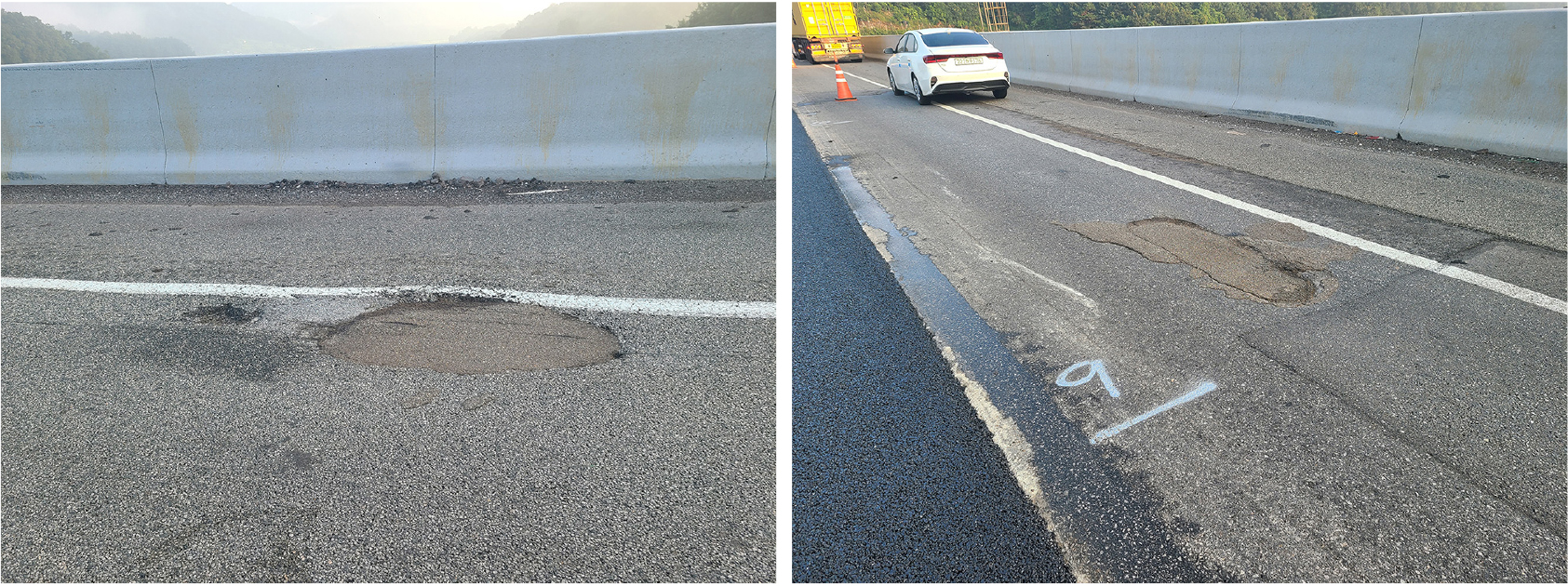
Fig. 1.
(a) Rutting & porthole, and (b) Patching & stripping before maintenance (유지보수 전 소성변형, 포트홀1(a) 및 국부 파손 및 박리 발생1(b))
에폭시 방수공법의 시공과정은 다음과 같다. Fig. 1은 유지보수 전 교면포장 상태(Fig. 1(a), 1(b)를 보여준다. Fig. 2는 유지보수 대상 교량의 기존 교면포장을 절삭한 모습이다. 절삭 노면을 로더(청소용 솔차)로 청소하고(Fig. 3), 진공흡입청소차량으로 미세먼지 제거(Fig. 4), 열화부 제거(Fig. 5) 및 보수(Fig. 6), 노면 건조(Fig. 7), 프라이머 도포(Fig. 8), 에폭시 방수재 도포(Fig. 9), 중심기재 설치(Fig. 10), 방수공 완료 및 양생 (Fig. 11), SMA(stone mastic asphalt) 상하부 포장 시공(Fig. 12, Fig. 13)의 과정을 거쳐 교면포장 방수 시공은 완료되었다.
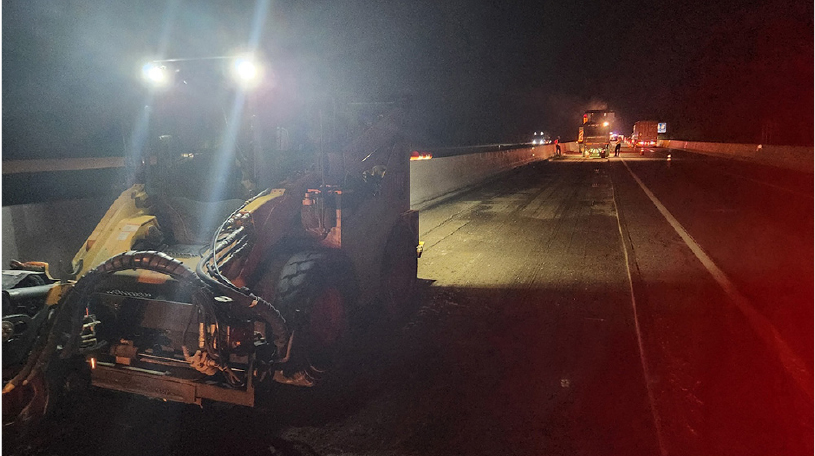
Fig. 2.
Bridge pavement remove (교면 포장 제거)
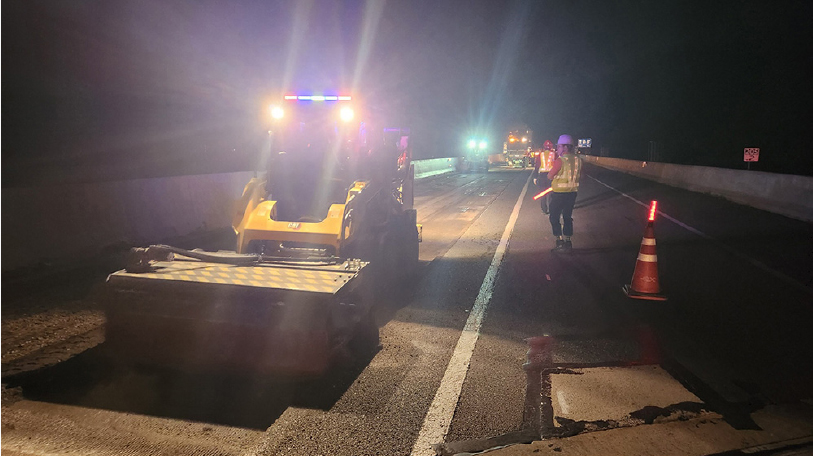
Fig. 3.
Cutting surface cleaning (절삭 노면 청소)
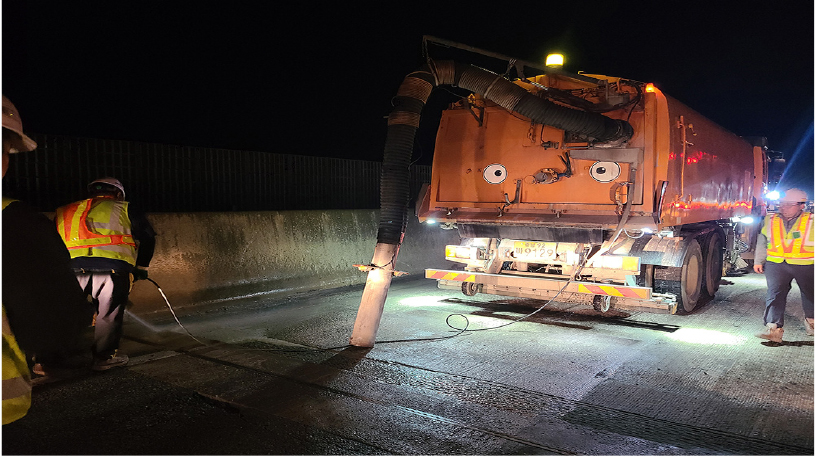
Fig. 4.
Vacuum suction cleaning (진공흡입차량 청소)

Fig. 5.
Remove the concrete slab degradation (콘크리트 슬래브 열화부 제거)
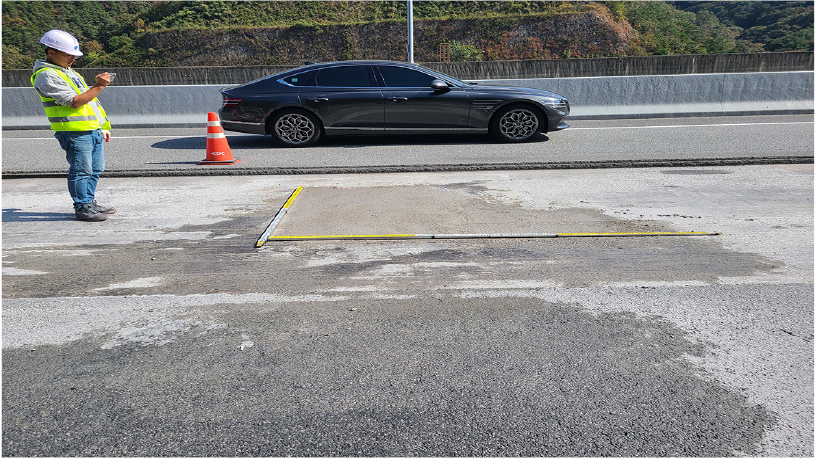
Fig. 6.
Repair the concrete slab degradation (콘크리트 슬래브 열화부 보수)
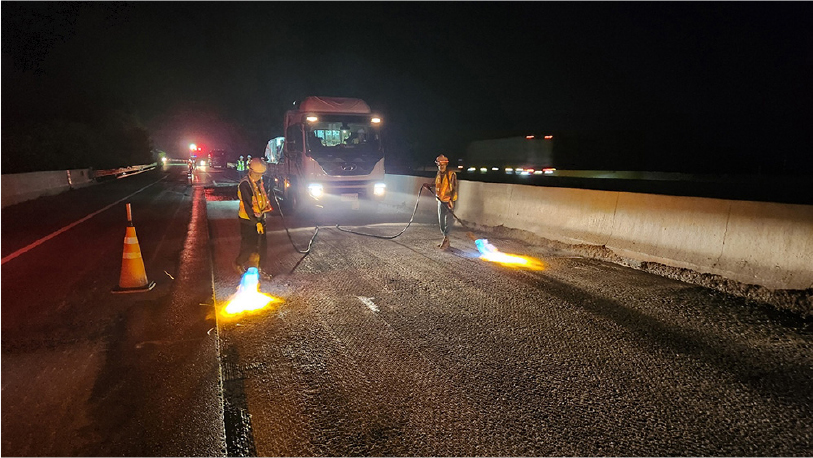
Fig. 7.
Cutting surface drying (절삭 노면 건조)
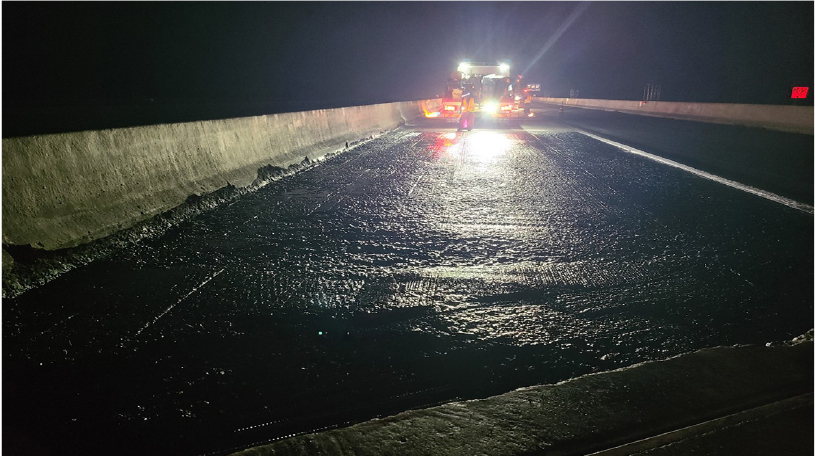
Fig. 8.
Primer application (프라이머 도포)

Fig. 9.
Epoxy waterproofing material application (에폭시 방수재 도포)
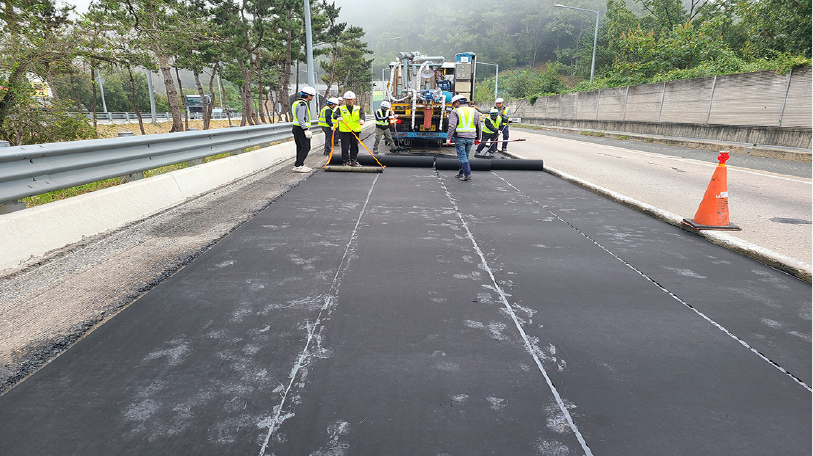
Fig. 10.
Non-woven installation (중심기재 설치)
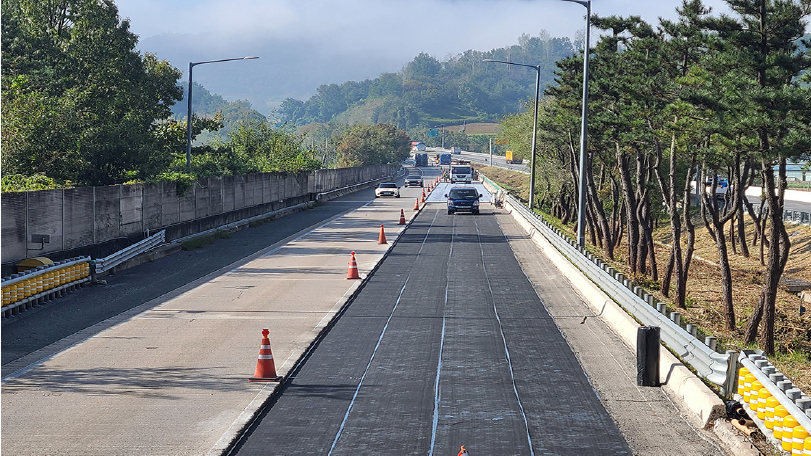
Fig. 11.
Waterproofing construction completed (방수 시공 완료 후)
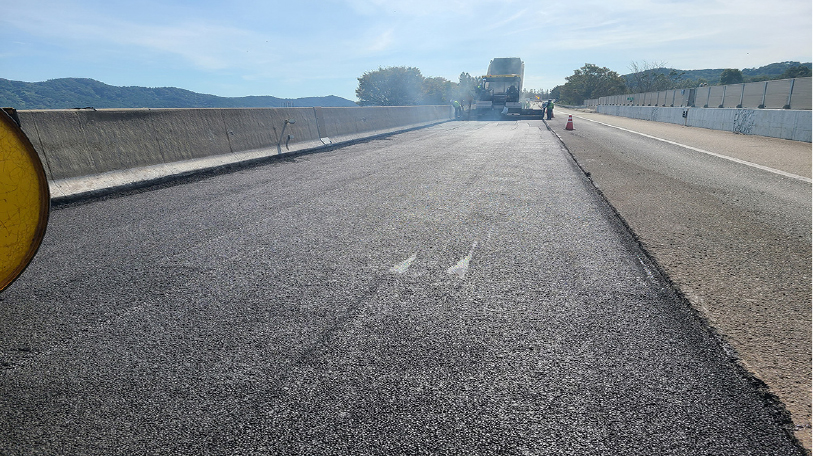
Fig. 12.
SMA(lower layer) paving (SMA 하부층 포설)
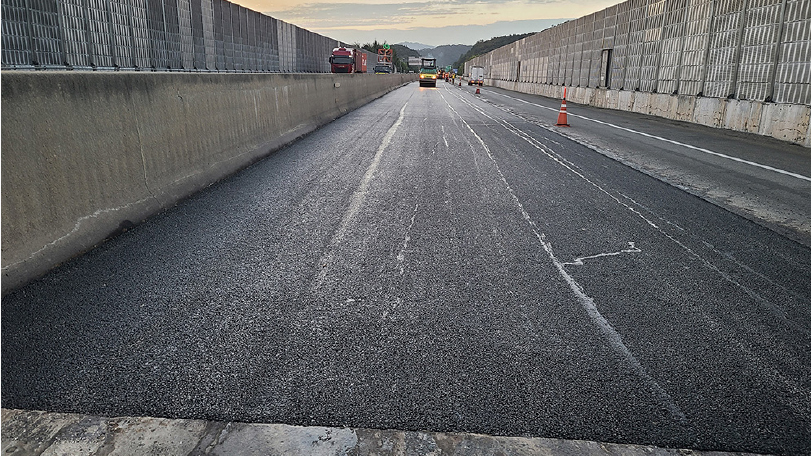
Fig. 13.
SMA(upper layer) paving (SMA 상부층 포설)
5. 시공결과 및 요약
본 기사에서 고속도로 교면포장 유지보수 시공에 에폭시 수지-경화제를 사용한 2액형 에폭시 역청계 방수공법을 적용한 시공 및 결과에 대하여 다음과 같이 요약하였다.
1. 에폭시 방수재(에폭시 수지+경화제)의 작업성과 양생 속도는 특별시방서에서 제시한 온도 범위에서 가열온도가 높을수록 시공에 유리하였다.
2. 교면포장 유지보수 시공 후 채취한 코어를 대상으로 방수재의 접착인장강도는 기준(0.6 MPa)을 만족하였다.
3. 단위면적당 방수재 사용량은 2.2~2.5 kg/m2으로 설계량 2.0 kg/m2보다 많이 투입되었다. 이는 절삭 노면의 요철에 의한 영향으로 판단되었다.
4. 에폭시 방수공법은 시공이 간단하고 방수성능과 내구성이 우수한 공법으로 향후 확대 적용이 기대된다.
5. 향후, 에폭시 방수 전용장비의 개선을 통해 시공 능력을 확대하고, 다양한 에폭시 수지에 대한 사용성 검토가 필요한 것으로 사료된다.

















